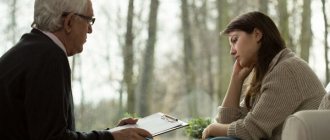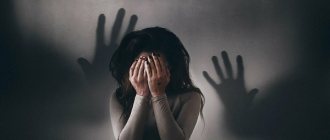06/18/20205 minutes read 1709
Phobia of getting sick or nosophobia is an atavistic, constant and obsessive fear, the same as the horror of death and madness. Let's be honest: who isn't afraid of contracting the new coronavirus or an incurable disease like cancer, AIDS, Ebola, etc.? The most common fear on this list of dangerous diseases is the fear of cancer. Aren't we afraid of suddenly going crazy? Aren't we afraid of death?
This article is entirely devoted to such a phobia as nosophobia: an irrational, strong horror of getting sick. In it we will look at how to get rid of this. The peculiarity of this condition is that the person does not think that he has an incurable disease at the moment, he is afraid of getting sick. This is what distinguishes it from hypochondria.
Hypochondriacs are not afraid of getting sick in the future; they go to doctors in the present and independently find all the existing symptoms of all existing diseases, and non-existent ones too. On the other hand, those suffering from such a scourge as nosophobia are mortally worried about the possibility of getting sick. Hypochondriacs are “sick” right now, nosophobes will be “sick” in the near future.
Coronavirus and nosophobia
The spread of coronavirus throughout the world has brought a huge number of changes to the lives of each of us.
We all began to use personal protective equipment, stopped going to crowded places and began to take personal hygiene much more seriously.
All this, of course, helps protect against coronavirus infection and prevents its spread, however, many of us have begun to experience a strong fear of getting sick, which for some people has developed into a real phobia.
Diagnostics
It is almost impossible to diagnose nosophobia on your own. Most likely, more than one month will pass before the patient, not finding any illnesses, turns to a psychotherapist for help.
During a conversation with the patient, the doctor assesses his condition and determines the presence of features characteristic of nosophobes:
- literacy, erudition, high level of intelligence;
- emotionality, sensitivity, developed imagination;
- the ability to discuss any disease, the desire to show oneself as a specialist in medical matters;
- deterioration in general well-being during the discussion of some illness;
- use of traditional medicine methods;
- watching medical programs, interest in new products in this field;
- visits to the doctor at the slightest change in health.
It is worth noting that nosophobes rarely turn to a psychotherapist voluntarily. In most cases, they are brought there by relatives or referred by another doctor.
What is nosophobia
Nosophobia is a phobic anxiety disorder, an intense fear of contracting any serious illness.
Due to the pandemic and the huge amount of information related to the epidemic, the number of people suffering from this disorder has increased. Many who were previously able to keep their fear under control by participating in social life and going about their daily routine began to experience real panic attacks during the period of self-isolation and increased information background associated with the disease.
How to distinguish between an adequate desire to protect oneself from the coronavirus pandemic and irrational fear, which is already nosophobia?
How to get rid of the fear of getting coronavirus
In general, 10 tips for reducing health fears can help with fear of illness, and coronavirus in particular.
1. Understand that fear is sold and you are being manipulated.
Panic sells and sells well, and the media knows it. So it's no surprise that every other headline warns you about the "Secret Dangers Living in Your Pillow." Or “The Deadly Dangers of Air Travel” or “Cancer-Causing Toxins in [fill in any name].”
We are safer than we have ever been in the history of mankind, and getting sick from something is not as terrible as it was a hundred years ago. But universal literacy, the emergence of news as entertainment, and the presence of a social feed. networks at hand have turned us into a society driven by phobias, afraid of incurable diseases, the risks of contracting which are relatively low. Understand that the media is trying to get you to read/watch/follow yourself by making you afraid of coronavirus, terminal cancer, and other constant and obsessive cravings. Refuse to be part of this game, and this will answer how to get rid of severe phobias.
2. Assess the real risk.
Yes, there are real health risks that can be avoided relatively easily. And why don’t you do everything possible to reduce them to a minimum, so as not to really get sick? But when you're constantly being told about low-risk but "high-impact" diseases, it's easy to lose perspective on how big the actual risk is. For example, when swine flu broke out, everyone was scared. But it turned out that swine flu is just a flu virus, and not smallpox or leprosy. And getting sick is not so scary. The same mass hysteria followed after the accident at the Japanese nuclear power plant after the tsunami and after any high-profile news event.
Instead of giving in to irrational fears, educate yourself. Find out the real risks and then make decisions accordingly.
3. Protect yourself from the media.
This advice is especially relevant during outbreaks of epidemics and pandemics, such as coronavirus. The coronavirus is being covered daily in the media, which is adding to people's panic. Take a media vacation and just pay attention to what happens to your fear levels. Try this, and then you will understand how to get rid of this fear forever. You might be amazed at how relaxed you'll feel just by giving up daily news for at least a week.
4. Tap into your inner knowing.
Some call it the inner pilot light—that wise, intuitive, body-focused part of you that will tell you whether you really need to worry or whether you can trust your sense of security.
5. Separate yourself from your fear.
We all have fears, especially when it comes to the possibility of getting sick or dying. But it is important to understand that fears arise in the amygdala of the brain, which is responsible for emotions and decision making. Their job is to protect us, but in modern times these fears often harm us more than they protect us.
Make friends with your fear, come up with a name and biography for it. Recognize that this is not you. And when you hear that voice of fear muttering, pat it on the head. Take courage and take steps to improve your health by aligning your nature with the image you desire - in your relationships, in your work, in your sex life, in your spiritual life, in your financial life, in your physical health and everything else. Understanding how to work with your fears will lead to happy relationships and life in general.
6. Push the boundaries of your comfort zone.
It seems natural to always stay in your comfort zone. But the more you go outside of it, the more you learn that areas just outside your comfort zone are probably safe too, and you don't necessarily have to get sick. If you typically relinquish power to your doctor during medical visits, try talking and asking questions about terminal illnesses. If you tend to be risk averse, try something risky (within reason, of course!) Repeated experimentation with testing situations outside of your comfort zone will rewire the amygdala, reduce fear, and help you feel brave.
7. Confirm your courage.
Try affirmations like “I am brave” or “I am in touch with my emotions.”
8. Surround yourself with brave people.
If you are surrounded by fear-driven people who project their fears onto you, it is not surprising that you feel afraid. Try to find brave people and see how their energy affects you. They will show by example how to get rid of nosophobia.
9. Trust the Universe.
As A Course in Miracles teaches, fear is the opposite of love and the two do not coexist. Essentially, by allowing fear to rule your life, you are telling the Universe that you do not trust it and that everything that happens is the highest good for all beings.
Letting go of fear and worry is the ultimate act of trusting that life is okay, that the universe doesn't need you to micromanage your life. That even if you get sick, it is only because the soul is here on this earth to learn something, and illness simply happens to be a means for this lesson. Let go of the steering wheel. Relax. Trust.
10. Talk to a qualified psychologist
While specific phobias do not always require treatment, nosophobia involves the fear of going anywhere where you might be exposed to a specific agent. This can make work, school and life in general difficult.
Therapy can be very useful for Nosophobia. The two main types of therapy used to treat fears are exposure therapy and cognitive behavioral therapy.
Exposure therapy:
This approach exposes you to what you fear in a safe environment, such as getting sick. A therapist will start by helping you develop tools to deal with the distress that comes with thinking about cancer or the coronavirus, such as meditation or relaxation techniques.
Eventually you will move on to confront some of these fears using the tools you have learned to help cope with nosophobia.
This exposure includes watching news about disease outbreaks, reading about various diseases, or spending time with people with the disease if it is not contagious.
Cognitive Behavioral Therapy (CBT)
Another useful practice is CBT. Although the therapist will include some level of intervention, CBT primarily focuses on teaching you to recognize and challenge irrational thoughts and fears.
The next time you start worrying, you will be able to stop and reconsider whether the thought is rational. Reframing irrational or anxious thoughts can help reduce anxiety.
Another important aspect of nosophobia practice is to help reduce the need to seek confirmation that you do not have a specific disease. A therapist can help you develop better coping tools that you can rely on when you need comfort from others. The good news is that if your nosophobia has become so severe that it prevents you from leaving the house, you can benefit from online psychological therapy. Specialized services, such as Helppoint, will select a specialist for you and provide an environment for communicating with a psychologist online. Via video call or private online chat. At any time and anywhere, as soon as anxious thoughts overcome you, your psychologist will be there and can help.
Treatment of nosophobia
Nosophobia responds well to therapy, but do not underestimate this disorder and treat it as something frivolous. This is a rather serious condition that requires timely and qualified assistance from a specialist. Nosophobia is treated both with psychotherapeutic methods and with the help of drug therapy.
Psychotherapeutic uses a variety of psychotherapy methods to help people suffering from nosophobia. The key to successfully combating this condition is timely contacting a specialist and receiving professional help.
Signs
Nosophobia manifests itself in psychological and somatic symptoms. The first include:
- excessive anxiety;
- panic in situations that can provoke the development of the disease (according to the person);
- depression, apathy, blues;
- difficulties in communicating with other people;
- limiting contacts.
The most common somatic signs of nosophobia are:
- lack of appetite;
- insomnia;
- heart rhythm disturbance;
- cardiopalmus;
- feeling of lack of air;
- lump in the throat;
- increased blood pressure;
- trembling of limbs;
- heavy sweating;
- chills;
- headache;
- nausea;
- stomach upset;
- dizziness;
- frequent urge to urinate.
The more such manifestations, the stronger the belief in the presence of a particular disease. A person considers even banal fatigue a sign of serious pathology.
Nosophobia can be easily identified by its behavior:
- undergoes medical examinations frequently and without reason;
- frequently performs hygiene procedures and is extremely clean;
- avoids sick people;
- spends a lot of time reading medical literature or watching relevant television programs;
- shows increased attention to well-being;
- always preoccupied with clothes, selects them strictly according to the weather;
- diagnoses himself and prescribes treatment.
These symptoms do not appear immediately, but develop gradually. So, at first there is a slight anxiety about the possibility of becoming infected with something. Next comes the suspicion of the presence of some disease. All this is accompanied by depression and melancholy. Obsessive thoughts are becoming stronger. Soon they are already accompanied by actions aimed at completely protecting themselves. Methods of classical and traditional medicine are used.











